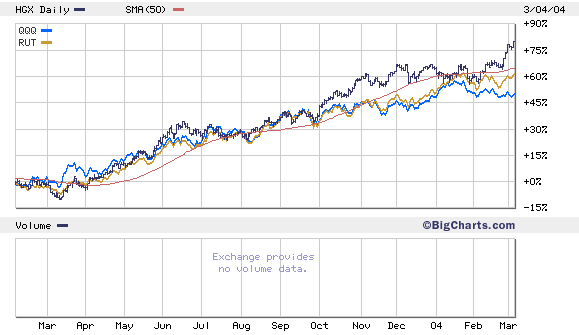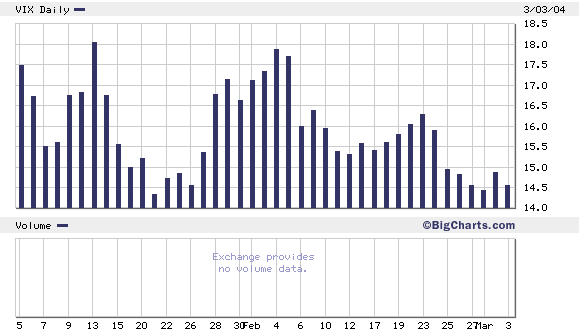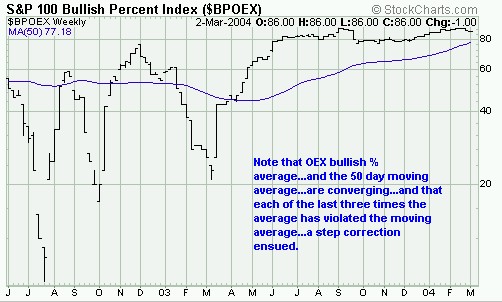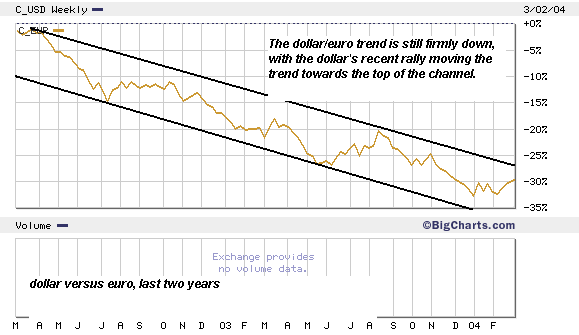The folks over at the DR (Bill and Addison) may cherry pick from this next week. But I figued I'd give you a sneak peek, for some weekend reading.
Believe those who are seeking the truth. Doubt those who find it.-- Andre Gide
Maybe Ben Bernanke doesn’t like gold because you can’t drop it out of helicopters without clouting people on the head. They might not even find it, much less spend it. The Kruggerands, St. Gaudens, and Loonies might lie there in the dirt, at home in the earth they came from.
They could lie for years, neglected, losing no intrinsic value. And should they be found by some fortunate passerby, he might have a good head on his shoulders and choose to keep the thing, rather than going out post haste and trading it for a TiVo and a bagel toaster.
Dropping money from helicopters is definitely easier, although it’s not a sure-fire guarantee for creating inflation.
Left to its own devices, paper money blows away, or gets soiled, weathered, and destroyed. It’s only useful if it’s rescued quickly, taken seriously, and passed on to the next unsuspecting person before he has time to think about it. This problem of how to get people to take paper seriously when there’s gold in the world is keeping Ben Bernanke up at night. And he’s sharing his night visions with us now, although I can’t guarantee you’re going to like them.
In case you missed it, Bernanke gave a speech titled “
Money, Gold and the Great Depression” on Monday. The speech was a revelation, and an admission. It reveals how seriously the Fed takes itself. But in the nature of its topic, it’s an admission that the Fed finds itself in a period of extreme monetary distress. Let’s take a look at a few key passages and, in the French tradition, deconstruct.
Bernanke says: “
The gold standard appeared to be highly successful from about 1870 to the beginning of World War I in 1914. During the so-called “classical” gold standard period, international trade and capital flows expanded markedly, and central banks experienced relatively few problems ensuring that their currencies retained their legal value. The gold standard was suspended during World War I, however, because of disruptions to trade and international capital flows and because countries needed more financial flexibility to finance their war efforts.”
We deconstruct: There was nothing “so-called” about the classical era. Gold was the foundation of sound money, money that didn’t just have “legal” value but “real” value.
The gold standard was “suspended” because with it, a government cannot finance a war with deficit spending.
Gold does not allow for “financial flexibility.” It demands fiscal responsibility from politicians and imperialists, which is like demanding the truth from a lawyer. The classical era was shucked because gold made it convenient to fight wars, and if there’s one thing human beings like more than getting rich, it’s killing one another over abstract ideas.
Gold provides a kind of “rule of monetary law” for the world. It is impartial and caters to no one ethnic group or bogus political ideology. It doesn’t require a brilliant idea to defend it or a stupid politician to support it. This lack of dependency on the vanity of man appears to offend Bernanke.
Bernanke says: “..
the new system {the gold standard after Word War I } lacked effective international leadership…. Unfortunately, the fledgling Federal Reserve, with its decentralized structure and its inexperienced and domestically focused leadership, did not prove up to the task of managing the international gold standard…With the lack of effective international leadership, most central banks of the 1920s and 1930s devoted little effort to supporting the overall stability of the international system and focused instead on conditions within their own countries.”
We recoil: Our hubris detectors are going off the charts. But then,
there’s always been a certain amount of unseemly pride in central bankers. They believe in free markets for everything but money. And they believe it takes men, not markets, to determine the appropriate price and supply of money. I include this excerpt because it reveals the Fed’s ambition more than anything, a dangerous ambition at that.
It’s also an ambition that flies in the face of past failures.
This Fed is thinking locally, but prepared to act globally, and that has nearly always been to the detriment of the American taxpayer. He sees his money wasted and his purchasing power eroded. The central beef against the ‘90s Fed, at least according to our friend Hugh Hendry, is that the Fed changed monetary policy in reaction to foreign events, i.e. the Mexican revaluation, the Russian default, the Asian Crisis, and the Argentine crisis.
It wasn’t enough for Greenspan to solve America’s monetary problems. He wanted to solve the world’s. Bernanke appears to share this ambition. The Fed is telling us it’s willing to make the same mistakes it made in the ‘90s, as many times as it has to. You can’t say you weren’t warned.
Bernanke says: “
The existence of the gold standard helps to explain why the world economic decline was both deep and broadly international. Under the gold standard, the need to maintain a fixed exchange rate among currencies forces countries to adopt similar monetary policies. In particular, a central bank with limited gold reserves has no option but to raise its own interest rates when interest rates are being raised abroad; if it did not do so, it would quickly lose gold reserves as financial investors transferred their funds to countries where returns were higher. Hence, when the Federal Reserve raised interest rates in 1928 to fight stock market speculation, it inadvertently forced tightening of monetary policy in many other countries as well. This tightening abroad weakened the global economy, with effects that fed back to the U.S. economy and financial system.”
We say: Fair enough. But a
system which facilitates global commerce, requires fiscal responsibility at the national government level, and punishes attempts to debase the purchasing power of the currency seems like a pretty good deal, at least if you want peace, price stability, and purchasing power.
The villain here is centralized control of the money supply and the ability to raise or lower borrowing costs on a whim, not gold. Also, notice his indirect defense of the Fed’s current policy concerning asset bubbles, namely: “Not our problem. And besides, look what happened last time we popped an asset bubble.” No mention is made of the Fed’s culpability in causing the bubble in the first place.
There’s some irony here, too, and how can we resist that?
The chief complaint against the gold standard is that it tied the hands of policy makers in each country. And the dollar standard is different how?
The world’s major central banks are currently engaged in attempts to rig the value of their currencies against the dollar. The only difference is that
the dollar, unlike gold, is a moving target, making it harder and more complicated to maintain the desired inferior relationship.
In its essentials,
the dollar standard is worse because, at bottom, there IS NO fixed value. Only relative. The current round of competitive currency devaluations is exactly the same dynamic at work years later. With gold, you couldn’t debase without getting punished. Gold was a harsh master.
With the dollar, you can’t debase quickly enough period. The U.S. is constantly making more of them, or borrowing through the bond market. The world is just as locked into the dollar standard as it was the gold standard. The chief difference is that
adherence to the dollar standard is going to bankrupt a lot of people, and there won’t be much gold left to fall back on, at least if not-so-gentle Ben gets his way.
Bernanke says: “
Perhaps the most fascinating discovery arising from researchers' broader international focus is that the extent to which a country adhered to the gold standard and the severity of its depression were closely linked. In particular, the longer that a country remained committed to gold, the deeper its depression and the later its recovery (Choudhri and Kochin, 1980; Eichengreen and Sachs, 1985).”
We say: Perhaps the most fascinating thing about this statement is how you could replace the word “dollar” for “gold” and not alter the meaning (or the warning) of the statement for modern investors.
Our prediction: the country that abandons the dollar first loses least. The longer you hold those billions in U.S. bonds, the less you’re going to get for them. Panic now and avoid the rush. You’ll also avoid having to deal with any Fed mischievousness, which Bernanke hints may be on the way.
Ben says: “
Finally, perhaps the most important lesson of all is that price stability should be a key objective of monetary policy. By allowing persistent declines in the money supply and in the price level, the Federal Reserve of the late 1920s and 1930s greatly destabilized the U.S. economy and, through the workings of the gold standard, the economies of many other nations as well.”
We say: Try not to laugh at the first line. And if you can contain yourself, the whole statement is pretty sobering. What word lingers over that paragraph without being uttered? Deflation.
Bernanke blames the depression on declines in the money supply, aka deflation. It’s clear he has no intention of allowing “consistent declines in the money supply.” But he’s still having trouble pumping up the price level. He just can’t seem to get consumer prices to rise fast enough, although if he looked at financial asset prices, he’d see all the inflation a man could want.
All joking aside,
this Fed is afraid of deflation. Profoundly, genetically afraid. It has become Ben Bernanke’s white whale. When Greenspan says the Fed can be “patient” about raising rates, he’s really saying the Fed will do just about anything to avoid repeat of the Depression, even if it means inflating to infinity, and beyond.
And in fact, Bernanke gives a glimpse of the great monetary beyond, with a wink, a nod, and a bow to the past. He says:
“
The finding that leaving the gold standard was the key to recovery from the Great Depression was certainly confirmed by the U.S. experience. One of the first actions of President Roosevelt was to eliminate the constraint on U.S. monetary policy created by the gold standard, first by allowing the dollar to float and then by resetting its value at a significantly lower level. The new President also addressed another major source of monetary contraction, the ongoing banking crisis. Within days of his inauguration, Roosevelt declared a "bank holiday," shutting down all the banks in the country. Banks were allowed to reopen only when certified to be in sound financial condition. Roosevelt pursued other measures to stabilize the banking system as well, such as the creation of a deposit insurance program. With the gold standard constraint removed and the banking system stabilized, the money supply and the price level began to rise.”
Yes indeed, the money supply and price level began to rise. But what will it take this time around?
What unorthodox measure will the Fed take once it’s “zero bound” and can’t cut rates? Buy goldmines? Why not? But commodities wholesale and give them to manufacturers? Why not, it’s already happening in Asia? Declare a moratorium on home foreclosures, or better yet, buy up all the mortgages in default? Why not? Confiscate gold again? Why not?
Why wait to find out, dear reader? Our finding is that leaving the dollar standard (getting your investment portfolio hedged against the dollar) will be the key to surviving this long, soft, slow motion depression. That, and of course, buying gold, unless Ben Bernanke thinks its so worthless he starts giving it away. In that case, if there are any helicopters around, duck.



 You also have the remergence of the traditional hammer with which U.S.-centric investors beat Europe: growth. That is, the jobs and ISM data support the thesis (yet to be confirmed by the Fed's Beige book and the labor market report on Friday) that job growth in the U.S. is back. This would be the final piece of the "recovery" argument and undeniably dollar bullish if, and this is a big if, growth was all that mattered. On the other hand, the European economy slugs along, plagued with its own systemic problems, and without the vaunted "growth" story you hear in the U.S.
Is growth all that matters? Of course not. Job growth (and more importantly, income growth) is an absolute must in the U.S. economy. But it's a must because of the high levels of U.S. debt, consumer, Federal, current account, you name it. The dollar bullish argument now is that U.S. economic growth can somehow, some way, render this enormous debt irrelevant.
Fundamentally, there's not much substance to this argument. You can inflate debt away, making it less costly by paying back in dollars worth less. Or you can simply forgive it...a giant, politically motivated debt amnesty (possible in the housing market.) Growing out of it--at these levels...would require both an increase in incomes and a huge decrease in spending, which would have a whole other set of economic consquences.
When the market has spoken on the dollar, it's sold it. Right now, the market is being shouted down by monetary authorities. These authorities are desperately trying to extricate them from a trap of their own making. They're going to fail. But in the short term, if it makes my beer a little cheaper, I won't complain.
The ECB speaks tomorrow and should leave rates unchanged. The job market report on Friday may even drive the dollar to new strength. But there's $7 trillion in government debt and a badly damaged consumer balance sheet weighing against the dollar. And on that issue, the currency market has already spoken with a bearish voice.
Don't be surprised if by the end of the year, you again see dollar euro 1.30 or more, and dollar British pound of 2.0 or more. In fact, this bullish foray buy the dollar makes the next few weeks an even better time to get into dollar bear positions for gains, once the short-term dollar bull runs out of gas.
You also have the remergence of the traditional hammer with which U.S.-centric investors beat Europe: growth. That is, the jobs and ISM data support the thesis (yet to be confirmed by the Fed's Beige book and the labor market report on Friday) that job growth in the U.S. is back. This would be the final piece of the "recovery" argument and undeniably dollar bullish if, and this is a big if, growth was all that mattered. On the other hand, the European economy slugs along, plagued with its own systemic problems, and without the vaunted "growth" story you hear in the U.S.
Is growth all that matters? Of course not. Job growth (and more importantly, income growth) is an absolute must in the U.S. economy. But it's a must because of the high levels of U.S. debt, consumer, Federal, current account, you name it. The dollar bullish argument now is that U.S. economic growth can somehow, some way, render this enormous debt irrelevant.
Fundamentally, there's not much substance to this argument. You can inflate debt away, making it less costly by paying back in dollars worth less. Or you can simply forgive it...a giant, politically motivated debt amnesty (possible in the housing market.) Growing out of it--at these levels...would require both an increase in incomes and a huge decrease in spending, which would have a whole other set of economic consquences.
When the market has spoken on the dollar, it's sold it. Right now, the market is being shouted down by monetary authorities. These authorities are desperately trying to extricate them from a trap of their own making. They're going to fail. But in the short term, if it makes my beer a little cheaper, I won't complain.
The ECB speaks tomorrow and should leave rates unchanged. The job market report on Friday may even drive the dollar to new strength. But there's $7 trillion in government debt and a badly damaged consumer balance sheet weighing against the dollar. And on that issue, the currency market has already spoken with a bearish voice.
Don't be surprised if by the end of the year, you again see dollar euro 1.30 or more, and dollar British pound of 2.0 or more. In fact, this bullish foray buy the dollar makes the next few weeks an even better time to get into dollar bear positions for gains, once the short-term dollar bull runs out of gas.
